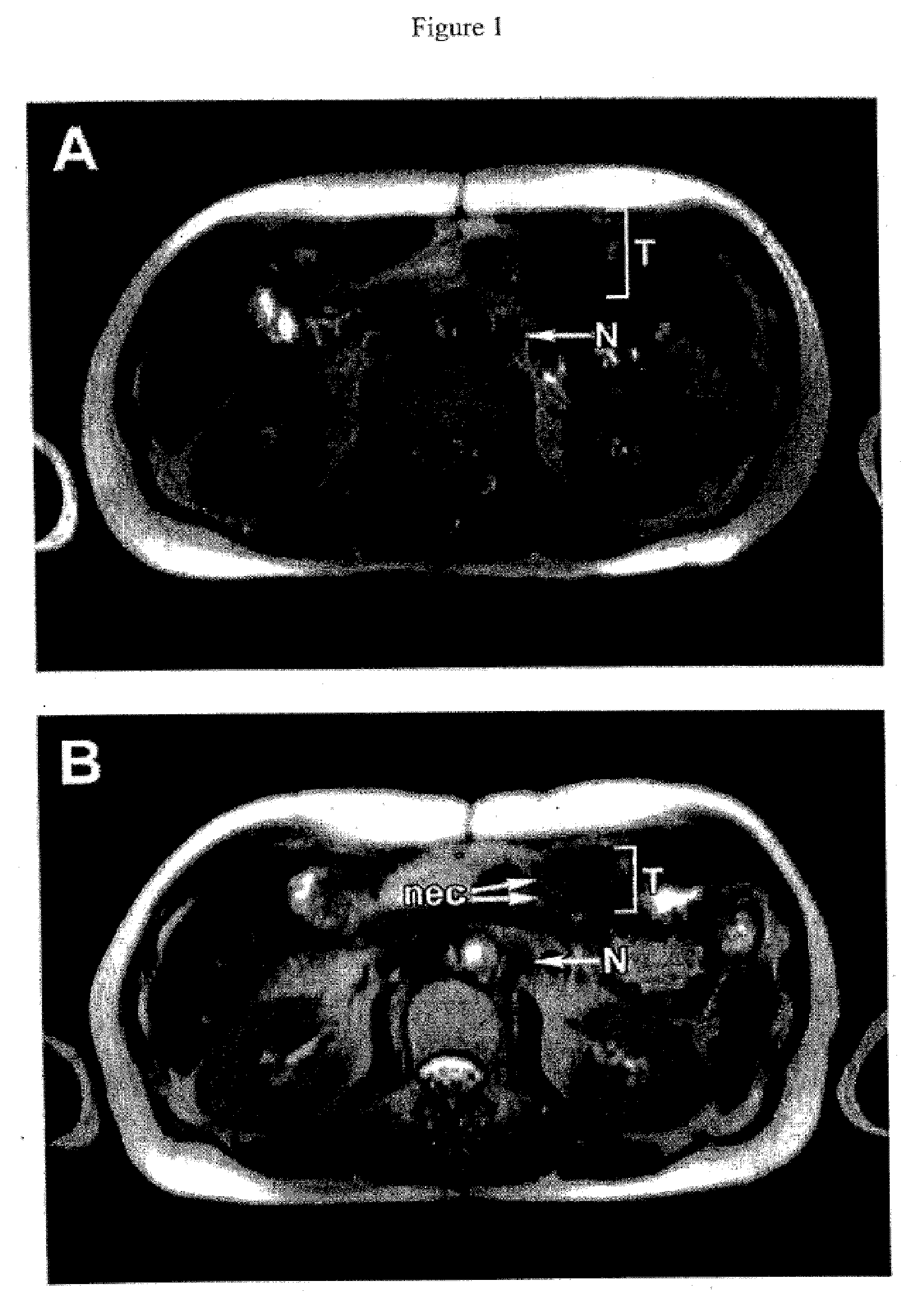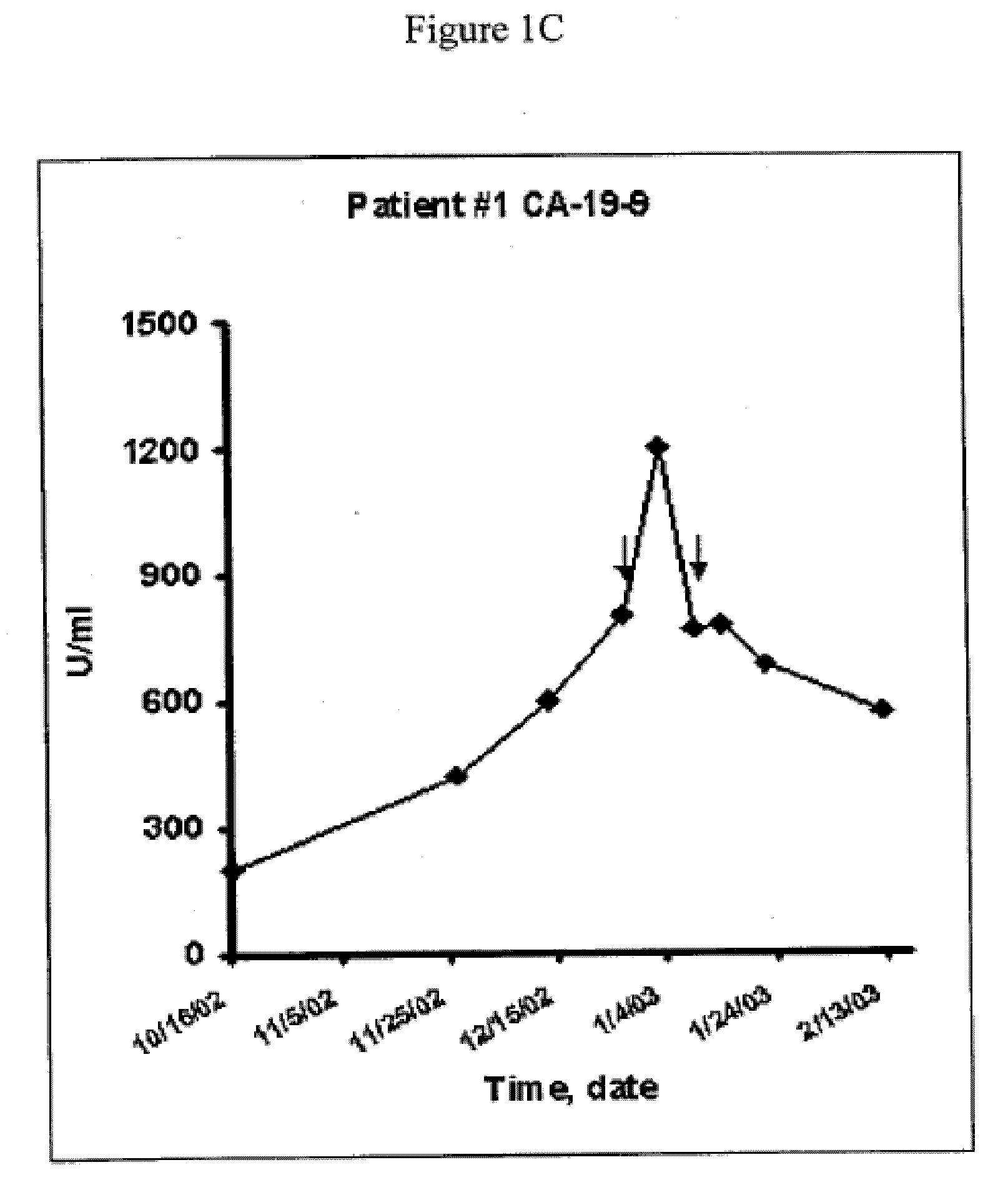Pathotropic targeted gene delivery system for cancer and other disorders
a gene delivery and cancer technology, applied in the field of cancer and other disorders, can solve the problems of many side effects, ineffective development and deployment of effective delivery systems, and inability to effectively target cells in vivo, so as to improve quality of life, prevent or ameliorate disease, and reduce or eliminate side effects
- Summary
- Abstract
- Description
- Claims
- Application Information
AI Technical Summary
Benefits of technology
Problems solved by technology
Method used
Image
Examples
example 1
Constructs
[0260]The plasmid pBv1 / CAEP contains coding sequences of the 4070A amphotropic envelope protein (GenBank accession number: M33469), that have been modified to incorporate an integral gain of collagen-binding function (Hall et al., Human Gene Therapy, 8:2183-2192, 1997). The parent expression plasmid, pCAE (Morgan et al., Journal of Virology, 67:4712-4721, 1967) was provided by the USC Gene Therapy Laboratories. This pCAE plasmid was modified by insertion of a Pst I site (gct gca gga, encoding the amino acids AAG) near the N-terminus of the mature protein between the coding sequences of amino acids 6 and 7 (pCAEP). A synthetic oligonucleotide duplex (gga cat gta gga tgg aga gaa cca tca ttc atg gct ctg tca gct gca, encoding the amino acids GHVGWREPSFMALSAA, a minimal collagen-binding decapeptide (in bold) derived from the D2 domain of bovine von Willebrand Factor (Hall et al., Human Gene Therapy, 11:983-993, 2000) and flanked by strategic linkers (underlined), was cloned int...
example 2
REXIN-G
[0272]The final product, Mx-dnG1 (REXIN-G™), is a matrix (collagen)-targeted retroviral vector encoding a N-terminal deletion mutant human cyclin G1 construct under the control of a hybrid LTR / CMV promoter. The vector also contains the neomycin resistance gene which is driven by the SV40 early promoter.
[0273]The Mx-dnG1 vector is produced by transient co-transfection with 3 plasmids of 293T (human embryonic kidney 293 cells transformed with SV40 large T antigen) cells obtained from a fully validated master cell bank.
[0274]The components of the transfection system includes the pdnG1 / C-REX therapeutic plasmid construct which contains the deletion mutant of the human cyclin G1 gene encoding a.a. 41 to 249 driven by the CMV immediate early promoter, packaging sequences, and the bacterial neomycin resistance gene under the control of an internal SV40 early promoter. The truncated cyclin G1 gene was initially cloned into a TA cloning vector (Invitrogen), followed by Not I / Sal I dig...
example 3
Therapeutic Efficacy of the Mx-dnG1 Vector
[0283]The efficacy of Mx-dnG1 in inhibiting cancer cell proliferation in vitro, and in arresting tumor growth in vivo in a nude mouse model of liver metastasis, was tested. A human undifferentiated cancer cell line of pancreatic origin was selected as the prototype of metastatic cancer. Retroviral transduction efficiency in these cancer cells was excellent, ranging from 26% to 85%, depending on the multiplicity of infection (4 and 250 respectively). For selection of a therapeutic gene, cell proliferation studies were conducted in transduced cells using vectors bearing various cyclin G1 constructs. Under standard conditions, the Mx-dnG1 vector consistently exhibited the greatest anti-proliferative effect, concomitant with the appearance of immunoreactive cyclin G1 at the region of 20 kDa, representing the dnG1 protein. Based on these results, the Mx-dnG1 vector was selected for subsequent in vivo efficacy studies.
[0284]To assess the performan...
PUM
| Property | Measurement | Unit |
|---|---|---|
| diameter | aaaaa | aaaaa |
| diameter | aaaaa | aaaaa |
| diameter | aaaaa | aaaaa |
Abstract
Description
Claims
Application Information
 Login to View More
Login to View More - R&D
- Intellectual Property
- Life Sciences
- Materials
- Tech Scout
- Unparalleled Data Quality
- Higher Quality Content
- 60% Fewer Hallucinations
Browse by: Latest US Patents, China's latest patents, Technical Efficacy Thesaurus, Application Domain, Technology Topic, Popular Technical Reports.
© 2025 PatSnap. All rights reserved.Legal|Privacy policy|Modern Slavery Act Transparency Statement|Sitemap|About US| Contact US: help@patsnap.com



